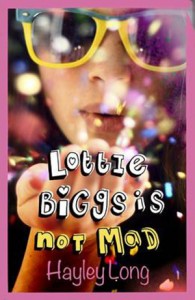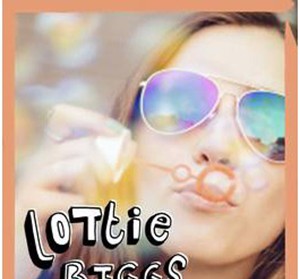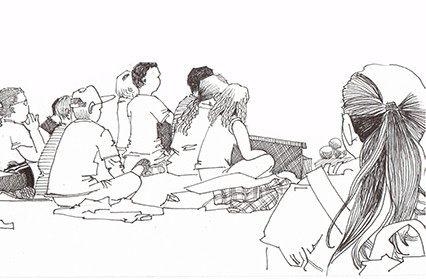Lottie Biggs’ award-winning author of young adult novels, Hayley Long, says ‘nuff respec’ to the writers of serial fiction.
I remember my first meeting with a London literary agent very clearly. I was anxious. My voice – once trained to be TEFL teacher clear – had withered to a mumble. I think I was sweating too much. And each time a question was put to me, the pause before I spoke was so protracted that the two people sat on the opposite side of the enormous table might reasonably have wondered if I had once suffered a monstrous bang on the head.
Let’s change tense and make it more dramatic.
Around us are walls lined from floor to ceiling with bookshelves. I can’t ignore four walls of books. I just can’t. Not even during a meeting of seismic personal importance. My eyes dart about in all directions. On one wall, I spot plastic-wrapped first editions of novels I read for my A Levels. On another, there are books in languages I can’t even identify. And everywhere I look, I see the familiar spines of award winners and bestsellers. The shelves are creaking under the weight of wordy success.
‘You’ll have to rewrite it,’ says one of the women opposite me. It’s not a question; it’s a statement – and she taps her perfect nails on a bulging blue cardboard folder. Unlike the nails, the folder is not perfect. It’s a bit scrunched at the edges. The price is still stuck on the front. 55p.
 My unpublished novel. Lottie Biggs is Not Mad.
My unpublished novel. Lottie Biggs is Not Mad.
There’s a weirdly long pause while I peel my gaze off the shaming price sticker and think about this. Rewrite it? A second passes. Five seconds? Five minutes?
And then I mumble, ‘Ok’. And start sweating again.
The two women across the table seem pleased with my answer. ‘I think this could be good,’ says the other woman who is older and holds all the aces. ‘There’s room out there for Lottie Biggs. I can see her as a serial.’
Another massive pause as I grapple with this. The thought of more Lottie Biggs has never occurred to me. I’m definitely a one-idea-at-a-time kind of person.
‘Ok,’ I mumble.
The older woman leans forward with the hint of a twinkle in her eye. ‘There’s room for you too.’ And she names a massive selling writer of serialised teen fiction and says, ‘She’s going off the boil’. I see that twinkle again. This time I’m sure it’s there.
And all of a sudden, I surprise myself. Because I open my mouth and say the most assertive thing I’ll manage in the entire meeting. It’s not a mumble either. It’s TEFL teacher clear and distinct.
‘To be fair,’ I say, ‘She has written ten books in that series. Ten. That’s a massive achievement, I think.’
And then I snap my blabby gob shut and wonder if I’ve spoken out of turn.
Apparently not. The women share a sideways look and then break out in grins. The atmosphere lightens a little. They talk – admiringly – about that massively successful teen fiction writer. They talk about what I must do to make my own book better. I nod and mumble a few more OKs. And then I shake hands with both of them and leave this book-stuffed set of rooms in an extraordinary listed building in Central London. I am no less anxious than when I arrived – but now I have the benefit of a literary agent helping me.
 Seven years on, I’m glad I said that – about a ten book series being an achievement. Experience has made me more sure of this than ever. After Lottie Biggs is Not Mad, I wrote two more books about my Welsh teenager – Lottie Biggs is Not Desperate and Lottie Biggs is Not Tragic. I like them all equally. They can be read as standalones or they can be read as a unit. And whilst the bar was raised when the International Youth Library awarded the first book a White Raven label for outstanding children’s fiction, I’ve never worried that Desperate and Tragic aren’t up to scratch. I think they are. In fact, it’s one of these follow-ons that’s my own personal favourite. I won’t be more specific than that. Seems wrong somehow. A bit like choosing between children.
Seven years on, I’m glad I said that – about a ten book series being an achievement. Experience has made me more sure of this than ever. After Lottie Biggs is Not Mad, I wrote two more books about my Welsh teenager – Lottie Biggs is Not Desperate and Lottie Biggs is Not Tragic. I like them all equally. They can be read as standalones or they can be read as a unit. And whilst the bar was raised when the International Youth Library awarded the first book a White Raven label for outstanding children’s fiction, I’ve never worried that Desperate and Tragic aren’t up to scratch. I think they are. In fact, it’s one of these follow-ons that’s my own personal favourite. I won’t be more specific than that. Seems wrong somehow. A bit like choosing between children.
To me, each of those Lottie books is distinct. When writing Lottie Biggs is Not Mad I had no thoughts beyond that story. I was writing a novel about teenage depression – but I absolutely didn’t want it to be pessimistic and depressing. Instead, I wanted to give my young readers an overriding sense of hope. And that was it. That was the whole of my vision. When suddenly faced with the task of producing another couple of volumes, there was no way I was about to sit down and write more of the same. I couldn’t even if I’d wanted to. I’ve got a restless head. And if I’m bored, it shows. So I found ways to keep myself challenged and interested. In the second book, I lessened the focus on depression and looked, instead, at teen relationships. Lottie is desperate to do it. Her hunky boyfriend, Gareth, isn’t. It’s all about the comedy. And why not? Depression is not always a constant. It comes and goes. There are other emotions and experiences. In the third book, I change course again. Older and wiser, Lottie is now dabbling in philosophy to help her make sense of her life. She quotes Descartes and Socrates and Søren Kierkegaard. And crucially, she learns to look objectively at her own behaviour. It’s a rite of passage. If we were being flashy, we might even say it’s a bildungsroman.
Except that we probably won’t. Because such terms seem to belong exclusively to the world of literary fiction. Not to teen fiction. Not to books with bright covers clearly targeting girls. And certainly not to serial fiction.
Instead, my books are most likely to be described as light. Or fun. Or sometimes fluffy. I don’t mind. The opposite would be dark, miserable and rough.
Teenagers have a lot of choices these days. They’re far less likely to experience the brain-crushing boredom I remember from my own early teens in the 1980s – that sense of almost being driven bananas because I didn’t know what to do. Books were like medicine to me. I opened one up. I stopped being bored. And I read anything. Teen stuff. Classics. My dad’s autobiographies about rock-climbers and round-the-world yachtsman – anything that I could get my hands on, I read it. But times have changed. Kids’ time is often time-tabled for them. This club on Monday evening. That club on Tuesday evening. Weekends are spent sleeping in a tent or learning new dance moves at a stage school. And then there’s satellite TV and Xbox. Books now have far more competition than they ever did before. And many kids probably just don’t have the time to read them. The market for dark, miserable and rough teenage books was never a large and lucrative one; now it’s more niche than ever.
So light, fun and fluffy are words I like. They put a smile on my face. It means that my books have been read in an effortless whirlwind. The tedious struggles I’ve had with sliding time frames have passed my reader unnoticed. The hours I’ve spent agonising about each individual word have been entirely hidden. Difficult subjects and new viewpoints have been absorbed into the sub-consciences of teenagers I’m never likely to meet. Something that I’ve found very difficult to do now looks like a creative breeze.
I suppose this is true of all my books. They’ve all been described as a light read at some point or other. Only I know they weren’t a light write. For me, each finished book feels like a conquered mountain. That point where you know it’s done is always a time for a huge glass of wine. Currently, I’m grappling with a novel whose structure is far too complicated. If my readers were adults, it might well be fine as it is – but they’re not. Not quite. And for me, simplicity is always the Holy Grail I’m seeking.
But still, the hardest writing challenge I’ve ever faced was turning one idea into three novels. A trilogy was enough for me. As much as I love her, I can’t imagine writing ten books about Lottie Biggs. Maybe one day, I’ll have an absolutely storming idea which could hold out for ten volumes. Right now, I have other standalone fish to fry and can’t even contemplate it. But my experience of writing my one little trilogy has given me enormous respect for those authors who can keep producing book after book in a series. It really isn’t an easy task. In fact, it’s a case of smoke and mirrors – an enormous sleight of hand. The writer of teen serial fiction is producing today’s answer to the bildungsroman – sometimes dressed in a paranormal or dystopian disguise – and creating the illusion that it’s easy.
And when they’ve finished, they do it again. And again. And again…
Lottie Biggs is Not Mad, Lottie Biggs is Not Desperate, Lottie Biggs is Not tragic and the Costa shortlisted standalone What’s up with Jody Barton? are all being reissued in July 2014 with very lovely new covers.
Banner illustration by Dean Lewis












